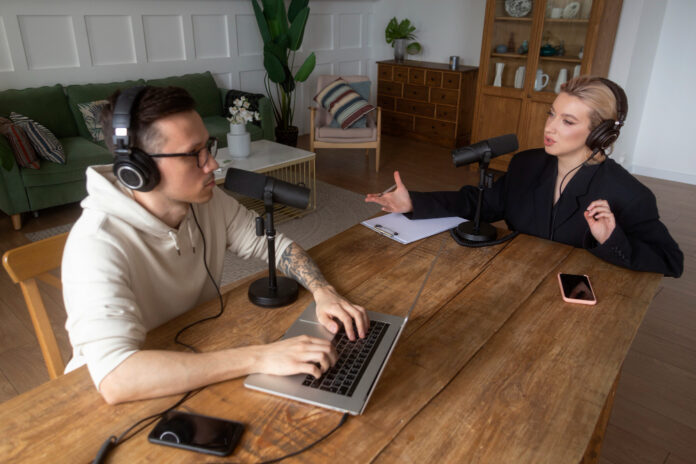Podcasters, live streamers, and audiophiles in the modern digital era cannot function without audio routing. Mastering the art of sending mic audio to another computer through a mixer may revolutionize your audio setup, whether you’re looking to delegate recording tasks, improve streaming performance, or simplify your setup in general. From the fundamentals of audio routing and mixers to specific, doable procedures for system setup, this book has you covered. Finally, to answer your most frequent questions, we have provided the most pertinent FAQs.
A Beginner’s Guide to Audio Routing and Mixing
Audio Routing: What Is It?
The act of guiding audible signals from a source to an intended receiver is called audio routing. It is uncommon for both residential and professional setups to have numerous computers, each dedicated to a certain purpose, such as recording on one machine and streaming on another. You may improve system efficiency and audio quality by using a mixer to route mic sounds from one machine to another.
Audio Routing and the Mixer’s Function
An audio mixer is the primary device for integrating and regulating audio signals. It allows you to control several inputs and outputs at once, add effects, and modify levels. When you wish to send audio from your microphone to another computer, the mixer’s dual purpose is to route the signal and optimize it for the receiving computer.
Why Is a Mixer Necessary for Audio Routing?
The levels, EQ, and effects of audio may be fine-tuned with the help of a mixer.
The use of a mixer can enhance the quality of a signal by decreasing noise and increasing clarity.
Adaptability: A blender’s various sound information sources and results simplify it to incorporate a large number of gadgets.
Job Segmentation: By routing audio across systems, you may use one computer for less resource-intensive activities (like streaming) and another for more resource-intensive duties (like recording or editing).
Important Pieces of Hardware and Software
In order to route your mic audio properly, you will need the following items:
A professional-grade microphone that can meet all of your recording requirements.
A digital or analog mixer with the appropriate input and output configurations is required for audio mixing.
Connectors and Extenders: These are the necessary connections to link your devices, such as XLR or TRS cables.
Interface for audio (if applicable): An audio interface allows you to connect your mixer to a computer without a direct USB output.
Two computers are required: one to record, transmit, or process the audio and another to manage the microphone input.
Software Factors to Keep in Mind
Sound recording and altering programming, for example, Daringness, Adobe Tryout, or Expert Devices is known as a computerized sound workstation (DAW).
To control audio streams across devices, you can use audio routing software like VoiceMeeter, Loopback (for macOS), or virtual audio cable solutions.
Always use the most recent version of your audio drivers for the best performance and compatibility.
A Comprehensive Tutorial on Sending Mic Signals to an External Device
1. Installation of the Microphone and Mixer
First Thing to Do: Hook Up Your Microphone
Utilize a XLR link to interface your amplifier to an info channel on the blender.
If your microphone needs phantom power (usually condenser mics), make sure the mixer’s phantom power feature is turned on.
2. Modify the Mixer Parameters
To get a clean, robust signal free of distortion, adjust the mixer’s gain knob to the microphone channel.
Make the equalization adjustments that work best for your instrument or voice, cutting off any extraneous frequencies and boosting clarity.
Linking the Mixer to the Message-Sending PC
Link the mixer’s output to your computer.
You may connect the mixer’s output to your transmitting computer’s line-in or microphone input using a suitable cable, like a TRS to 3.5mm connector.
To get a digital signal from your mixer, plug it into a computer’s USB port if it has one.
Adjust the Computer’s Sound Preferences
Go to the audio settings to make the mixer (or linked audio interface) the main input device on the computer for transmitting.
Adjust the input settings to ensure the mic audio isn’t clipping and that the signal-to-noise ratio is good.
Directing Sound to the Recipient’s Machine
Playing Back Audio from the Originating PC
To transfer audio from one computer to another, you may use audio routing software like VoiceMeeter. Just be sure to configure a virtual output on the transmitting machine.
On the other hand, you could link the two computers’ line-in ports via a physical audio connection. One machine might provide audio, while the other could receive it.
The sixth step is to prepare the receiving computer.
Choose the virtual or actual audio source that is coming in as the input device in your recording or streaming program on the receiving computer.
Speak into the microphone to ensure the computer receiving the signal can hear you well, then check the audio.
Checking and Adjusting the Configuration
Check the Soundproofing
Run a sound check to ensure that the volume on both the transmitting and receiving PCs is the same.
Be sure to watch for signal deterioration or delay. You can also tweak the buffer widths in your audio program as needed.
Confirm and Save Settings
Remember to save the setup on both machines once you’re happy with it.
Make sure to document your setup so you can go back to it and troubleshoot if needed.
Mastering the Art of Audio Routing
Invest in Separate Audio Interfaces
If your mixer does not have USB connectivity, consider purchasing a high-quality audio interface to make routing easier. Audio interfaces are essential for professional-grade audio production and provide high-quality digital conversions with low latency.
Make Use of Digital Mixers
In addition to powerful routing features, digital mixers often come with built-in effects, software for remote control, and the ability to record directly into the device. These capabilities increase your setup’s versatility by allowing you to handle many audio sources across several machines more easily.
Investigate Tools for Virtual Audio Routing
To circumvent hardware restrictions and complicated installations, you may use virtual audio routing software such as Loopback for macOS or VoiceMeeter for Windows. These technologies allow you to transport audio channels between apps and hardware easily.
Keep an eye on and compromise on latency.
Latency is a major problem with audio routing between computers. To ensure your music stays in sync and has no perceptible delays, adjust the buffer sizes and sample rates in the software’s options.
Updating and Maintenance on a Regular Basis
Always use the most recent firmware and driver versions for your mixer, audio interfaces, and routing software. Regular maintenance is essential to keeping compatibility concerns at bay and performance at its peak.
Fixing Typical Problems
No sound is being picked up.
Verify Connectors: Make sure every cable and connection is firmly fastened. A dangling wire may cause signal strength loss.
In the software preferences, make sure that both machines have the right input and output devices chosen.
Verify that the output volume of the mixer is not muted or set too low in the settings.
Buffer Size for Audio Latency or Delay: Tweak the buffer size of your audio program to achieve a happy medium between latency and performance.
Digital connections (via a USB or digital audio interface) often have lower latency than analog ones.
Software Assets: Turn down unused programs on both devices to make room for more processing power.
Low-quality or Noisy Audio
Problems with ground loops, which might lead to interference or hum, should be investigated. Balanced cables might lessen this impact.
To avoid electromagnetic interference, keep audio wires away from power lines and other electrical appliances.
Adjust the equalization controls on your mixer to cut out background noise and boost clarity.
Question of Compatibility
Keep your computer’s audio drivers and the firmware on your mixer up-to-date.
Software ConIfudio routing software can clash programs at the same time. As a fi, they can clash steps in troubleshooting; try turning off any unused programs.
Read About – The Mystical Cinderella Mice | The Fairy Tale’s Most Delightful Sidekicks
Answers to Common Questions
1. With a mixer, how can I send audio from a microphone to another computer?
The correct way to do it is to hook up your microphone to a mixer and then link the microphone’s output to the input of the computer that will be providing the signal. To send the signal to the destination computer, you can use a real connection or use virtual audio routing software.
2. What kinds of wires are required for this setup?
The standard connection between a microphone and a mixer is an XLR cable, whereas a computer and the mixer are often linked via TRS or 3.5mm connections. The specific wires could be different depending on the connections on your equipment.
3. Is it possible to route audio between machines using a USB mixer?
Many newer USB mixers make it easy by transmitting digital music straight to your computer, so the answer is yes. In comparison to analog connections, this usually improves sound quality while reducing latency.
4. What are the ways to completely remove delay from audio routing?
Use a digital connection, tweak the audio software’s buffer sizes, and make sure both computers are powerful enough to reduce latency. Specialist audio interfaces might also be helpful.
5. If the receiving computer does not show any audio, what am I to do?
Before you continue, your wires and other physical connections should be in good working order. The next step is to double-check that both computers’ software settings are configured to the right input devices. Lastly, make sure your audio routing software is up-to-date and that there are no conflicts or driver changes.
Conclusion
Whether you’re making podcasts, streaming, or recording, you may greatly improve your audio process by routing microphone sounds to another computer with a mixer. In order to ensure high-quality audio output without overwhelming any one device, you may optimize each computer for its assigned duty by following this complete instruction.
Steps include hooking up your microphone to a mixer, setting up your computers to send and receive signals, and fixing typical problems like signal deterioration and delay. With the correct equipment, software, and a little effort, you can accomplish seamless audio routing that matches your professional demands.
Everything you do, from the connections you select to the configurations you tweak, affects the sound quality of your finished audio system. Check out our Audio Equipment Setup Guide and other relevant sites for more insights on audio equipment and professional recording techniques.
Incorporate a well-configured mixer into your workflow for improved control and quality, and relish in the freedom that comes with routing mic audio across machines. Happy recording and streaming!


